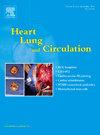一个基于心率、年龄和收缩压的简单预后指标用于保留射血分数的心力衰竭风险分层。
IF 2.2
4区 医学
Q2 CARDIAC & CARDIOVASCULAR SYSTEMS
引用次数: 0
摘要
目的:一种快速有效的风险分层方法对保留射血分数(HFpEF)急性心力衰竭患者的急诊护理具有重要意义。先前的研究(包括我们自己的研究)表明,心率、年龄和收缩压与HFpEF的病理生理有关。本研究旨在探讨溶栓对心肌梗死风险指数(TRI)的预测效用,该指数由心率、年龄和收缩压组成,用于确定急性HFpEF患者的住院死亡率。方法:这项多中心回顾性研究纳入了7040例急性HFpEF患者。TRI计算公式为:TRI=(心率×年龄/10)/收缩压。采用单变量和多变量Cox回归分析确定院内死亡率的预后因素。采用受试者工作特征曲线分析评价TRI对院内死亡率的预测能力。结果:根据tri,住院死亡率从低四分位数组到高四分位数组显著增加。单变量和多变量Cox回归分析确定TRI是院内死亡率的独立预后因素。最佳截断TRI值为35,TRI≥35预测院内死亡率的敏感性为82%,特异性为42%,阳性预测值为66%,阴性预测值为98%。结论:简单的TRI工具是急性HFpEF患者住院死亡率的重要预测指标,提示这种快速、直接的风险分层工具可用于日常临床实践。本文章由计算机程序翻译,如有差异,请以英文原文为准。
A Simple Prognostic Index Based on Heart Rate, Age, and Systolic Blood Pressure for the Risk Stratification of Heart Failure With Preserved Ejection Fraction
Aim
A rapid and effective risk stratification method is highly important for the emergency care of patients with acute heart failure with preserved ejection fraction (HFpEF). Previous studies, including our own, have suggested that heart rate, age, and systolic blood pressure contribute to the pathophysiology of HFpEF. This study aimed to examine the predictive utility of the thrombolysis in myocardial infarction risk index (TRI)—consisting of heart rate, age, and systolic blood pressure—for determining the in-hospital mortality in patients with acute HFpEF.
Methods
This multicentre retrospective study included 7,040 consecutive patients with acute HFpEF. The TRI was calculated as TRI=(heart rate × [age/10]2)/systolic blood pressure. Univariable and multivariable Cox regression analyses were used to identify the prognostic factors for in-hospital mortality. Receiver operating characteristic curve analysis was performed to evaluate the predictive ability of the TRI for in-hospital mortality.
Results
In-hospital mortality significantly increased from the low to the high quartile groups according to the TRIs. Univariable and multivariable Cox regression analyses identified the TRI as an independent prognostic factor for in-hospital mortality. The best cut-off TRI value was 35 and a TRI ≥35 had a sensitivity of 82%, specificity of 42%, positive predictive value of 66%, and negative predictive value of 98% for predicting in-hospital mortality.
Conclusion
The simple TRI tool is a significant predictor of in-hospital mortality of patients with acute HFpEF, suggesting that this rapid and straightforward risk stratification tool can be useful in daily clinical practice.
求助全文
通过发布文献求助,成功后即可免费获取论文全文。
去求助
来源期刊

Heart, Lung and Circulation
CARDIAC & CARDIOVASCULAR SYSTEMS-
CiteScore
4.50
自引率
3.80%
发文量
912
审稿时长
11.9 weeks
期刊介绍:
Heart, Lung and Circulation publishes articles integrating clinical and research activities in the fields of basic cardiovascular science, clinical cardiology and cardiac surgery, with a focus on emerging issues in cardiovascular disease. The journal promotes multidisciplinary dialogue between cardiologists, cardiothoracic surgeons, cardio-pulmonary physicians and cardiovascular scientists.
 求助内容:
求助内容: 应助结果提醒方式:
应助结果提醒方式:


